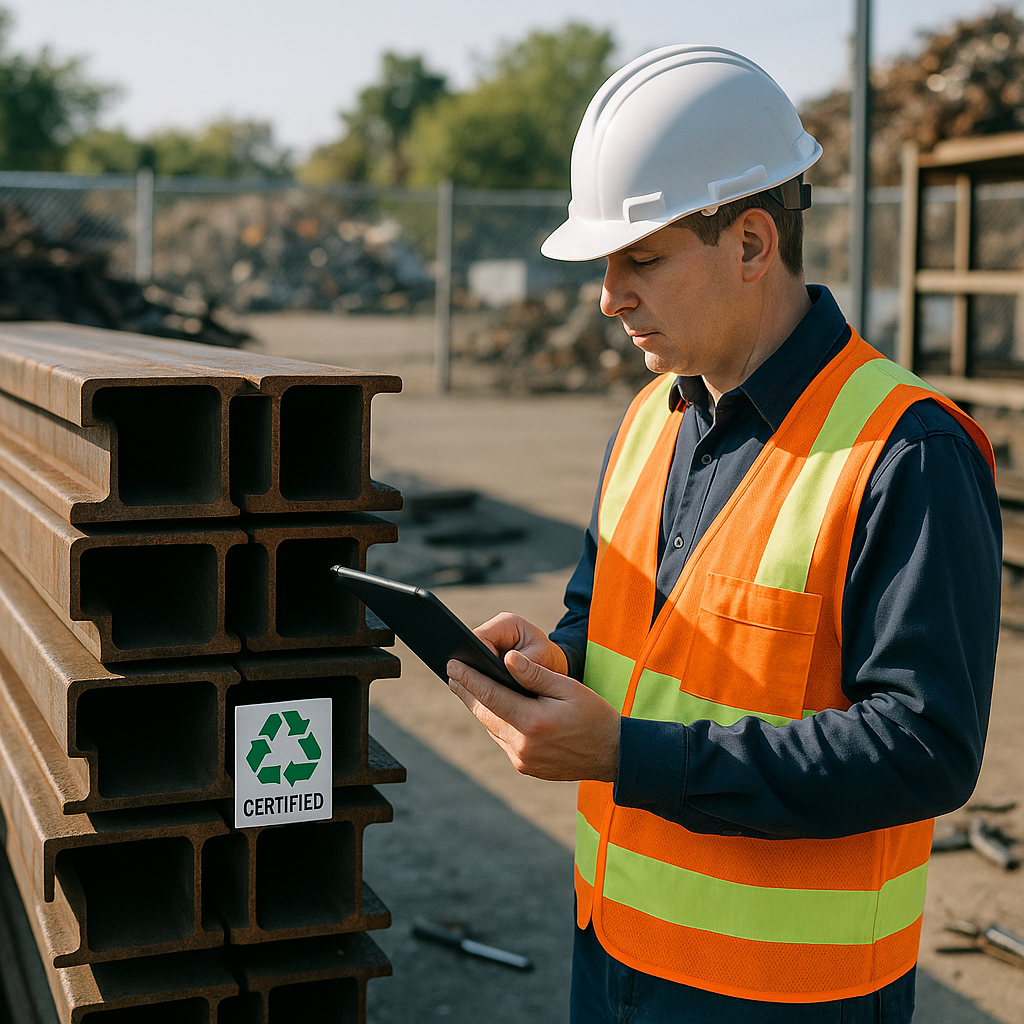5901 Botham Jean Blvd, Dallas, TX 75215
What Are the Key Steel Recycling Compliance Requirements?
June 5, 2025Steel recycling compliance requirements are standards and regulations that govern how steel is recycled, processed, and produced sustainably. These ensure recycled steel meets quality benchmarks while minimizing environmental impact. The steel industry, responsible for 7-9% of global carbon emissions, faces increasing pressure to adopt responsible practices.
The Responsible Steel International Standard, established in 2019, is the industry’s first global multi-stakeholder standard for sustainable steel production. This framework focuses on environmental, social, and governance (ESG) compliance throughout the steel recycling process. Companies seeking certification must adhere to strict protocols covering everything from greenhouse gas emissions to labor rights.
Steel recycling standards are increasingly important as manufacturers, municipalities, and sustainability officers seek materials that meet both performance requirements and environmental goals. With approximately 650 million tonnes of steel scrap contributing to about 30% of global steel production, proper compliance ensures this valuable resource maintains its quality through multiple life cycles.
How Does LEED Certification Impact Steel Recycling?

LEED (Leadership in Energy and Environmental Design) certification has become a significant driver for adopting recycled steel in construction. Developed by the U.S. Green Building Council, LEED offers a framework for creating healthier, more sustainable buildings while recognizing environmentally conscious construction practices.
LEED certification sets specific requirements for recycled content in building materials. The U.S. Green Building Council has established a default value of 25% recycled content for any steel product to qualify for certification. This benchmark has influenced material selection across the construction industry, encouraging builders to prioritize recycled steel options.
LEED v4, the latest version of the certification program, emphasizes material transparency and environmental impact. Steel excels in this framework due to several key factors:
- Steel products typically contain between 25% and 100% recycled content, meeting or exceeding minimum certification requirements.
- Steel is 100% recyclable at the end of its life with no quality degradation.
- The manufacturing process has reduced energy consumption by 31% since 1990.
- Associated carbon dioxide emissions have decreased by 36% during the same period.
Projects using recycled steel can earn points under multiple LEED credit categories. The Materials and Resources Credit is particularly relevant, with recycled steel contributing to both Credit 4.1 (10% recycled content) and Credit 4.2 (20% recycled content).
Beyond recycled content, steel offers additional sustainability benefits that align with LEED objectives. Its dimensional stability creates tighter building envelopes, enhancing energy efficiency. Steel components are manufactured to precise specifications, minimizing on-site waste. During demolition, steel’s magnetic properties facilitate easy separation and recycling.
With LEED certifications referenced in nearly 71% of construction projects exceeding $50 million, the program has transformed recycled steel from an optional green choice to an industry standard. As sustainability requirements evolve, steel’s recyclability positions it as a material of choice for environmentally conscious construction.
| Certification Level | Points Required | Recycled Steel Content Requirement |
| Basic Certification | 40 to 49 points | At least 25% recycled content |
| Silver Certification | 50 to 59 points | At least 25% recycled content |
| Gold Certification | 60 to 79 points | At least 25% recycled content |
How Does Designing for Deconstruction Affect Steel Recycling?

Designing for Deconstruction (DfD) fundamentally changes how steel structures are conceptualized, built, and eventually dismantled. This approach ensures buildings are created with their end-of-life in mind. Steel components are designed and assembled in ways that allow for easy disassembly, salvage, and reuse when the building reaches the end of its design life.
Unlike traditional construction methods where materials are often damaged during demolition, DfD preserves the structural integrity of steel elements. This makes them immediately available for reuse in new projects without extensive reprocessing. The concept directly addresses the construction industry’s massive resource consumption problem.
Core Principles of DfD for Steel Structures
Several key principles guide effective DfD implementation in steel construction. These principles ensure maximum material recovery and minimal waste generation when structures are eventually disassembled.
First, simplifying connection details is crucial. Using standardized, repeated, and consistent connection methods creates efficiency in both construction and later deconstruction. Bolted connections, rather than welded ones, allow for non-destructive disassembly of steel members.
Second, material selection and minimization play important roles. Using a limited variety of materials streamlines the deconstruction process. Prioritizing inherently reusable materials like structural steel keeps these valuable resources in circulation longer.
Third, modular design and prefabrication facilitate both assembly and disassembly. Components that are easily erected can just as easily be removed intact for reuse elsewhere. This approach particularly suits steel framing systems.
Environmental and Economic Benefits
The environmental advantages of DfD for steel construction are substantial and far-reaching. According to industry data, steel is already the most recycled building material by weight. DfD takes this further by enabling direct reuse rather than recycling.
DfD significantly reduces construction waste. When buildings reach their end of life, up to 90% of materials can be salvaged through proper deconstruction methods. This dramatically cuts landfill contributions from the construction sector.
The approach also reduces carbon emissions in multiple ways. Reusing steel eliminates the energy-intensive processes needed to recycle or produce new steel. Each ton of steel reused rather than newly manufactured saves approximately 1.5 tons of CO2 emissions.
From an economic perspective, DfD creates value at a building’s end of life. Instead of paying for demolition and disposal, building owners can potentially recover value through material salvage. Steel members retain significant worth when they remain intact and reusable.
Practical Implementation Challenges
While DfD offers clear benefits, implementation faces several practical challenges. Current building codes and standards may not fully accommodate DfD approaches. Construction professionals need updated regulations that recognize and facilitate demountable structures.
Documentation presents another challenge. Detailed records of a building’s materials, components, and connection methods must be maintained throughout its lifespan. These records serve as essential references for future deconstruction efforts.
Cost considerations also affect implementation. DfD may increase initial construction costs due to specialized connection systems and additional planning. However, these short-term costs should be weighed against long-term environmental benefits and end-of-life material value.
The construction industry’s established practices present perhaps the greatest barrier. Shifting from demolition to deconstruction requires new approaches, skills, and mindsets throughout the building sector.
The Role of Steelwork Contractors
Experienced steelwork contractors are essential to successful DfD implementation. They contribute specialized knowledge in designing steel frames that remain structurally sound while allowing for future disassembly.
These professionals ensure that connections between steel members use bolts rather than welds whenever possible. This small but crucial detail makes the difference between components that can be separated intact and those that require cutting or breaking.
Contractors also help design flexible, adaptable structures that can accommodate future changes in building use. Open-plan spaces and standardized components create buildings that can be easily reconfigured rather than demolished when needs change.
Additionally, steelwork contractors maintain detailed records of steel components and connections. This documentation becomes invaluable when buildings eventually require deconstruction.
| Aspect | Traditional Demolition | Design for Deconstruction |
|---|---|---|
| Process | Quick site clearance using heavy machinery | Careful disassembly for material recovery |
| Environmental Impact | High waste generation, materials often sent to landfills | Low waste, materials preserved for reuse |
| Material Reuse | Limited, often downcycled | High, materials are preserved intact |
| Cost | Lower initial cost | Higher initial cost, but potential for future savings |
| Time | Faster | Slower, requires more labor |
| Carbon Emissions | Higher due to new material production | Lower due to reuse of existing materials |
| Flexibility | Limited adaptability of structures | Structures designed for future changes |
Real-World Applications
DfD principles are increasingly visible in modern construction projects. Modern commercial buildings often incorporate bolted steel connections, modular components, and standardized elements that facilitate future disassembly.
Industrial buildings particularly benefit from DfD approaches. Their typically simpler designs and larger spans make them well-suited to bolted connections and modular components. When business needs change, these structures can be efficiently disassembled and relocated or repurposed.
Public buildings like sports facilities and exhibition halls also demonstrate DfD principles. These structures often require flexibility for different events and eventual upgrades, making demountable designs particularly valuable.
The construction industry continues to develop innovative technologies and methods that enhance DfD possibilities. Smart tagging of components, digital material passports, and advanced connection systems all contribute to more effective deconstruction processes.
What Are the Green Building Standards for Recycled Steel?

Green building standards provide frameworks for environmentally conscious construction practices. For recycled steel, these standards ensure that buildings meet specific sustainability criteria while delivering optimal performance. The International Green Construction Code (IgCC) is the primary governing system for these standards.
The IgCC sets comprehensive requirements across several key areas of sustainable building. It establishes baseline criteria for energy efficiency, ensuring that structures minimize consumption throughout their lifecycle. The code also addresses indoor environmental quality, creating healthier spaces for occupants. Additionally, it regulates emissions to reduce environmental impact and promotes sustainable site development practices.
Recycled steel naturally aligns with these green building standards. Its production process uses significantly less energy than manufacturing virgin steel, which directly translates to lower carbon dioxide emissions, making recycled steel an environmentally responsible choice. Steel products are also 100% recyclable at the end of their useful lives, creating a closed-loop material cycle.
The material’s durability represents another sustainability advantage. Steel-framed structures typically last decades with minimal maintenance requirements. This longevity reduces waste generation and conserves resources that would otherwise be used for repairs or replacements.
How Recycled Steel Meets Green Building Requirements
Under the International Green Construction Code, recycled steel contributes to sustainability in several specific ways. Most structural steel produced in North America contains 90 percent or more recycled content, exceeding the recycled content requirements of most green building standards. Steel framing typically contains a minimum of 25 percent recycled steel and remains continuously recyclable.
The indoor environmental quality benefits of recycled steel stem from its inert nature. Unlike some building materials, steel doesn’t emit volatile organic compounds (VOCs) that can compromise indoor air quality. This helps buildings achieve healthy indoor environment standards without additional mitigation measures.
Recycled steel also supports sustainable site development through its versatility and strength-to-weight ratio. Steel structures often require less extensive foundations than alternatives, minimizing site disruption. The precision manufacturing of steel components reduces on-site waste generation during construction.
| Standard | Requirements | Application to Recycled Steel |
|---|---|---|
| International Green Construction Code (IgCC) | Energy efficiency, Indoor environment quality, Emissions, Sustainable sites | Recycled steel is energy efficient and promotes indoor air quality since it doesn’t emit toxic substances. |
| ANSI / ASHRAE / USGBC / IES | Water efficiency, Sustainable site, Indoor environmental quality, Energy efficiency | Recycled steel is water and energy efficient. Moreover, it’s free of VOCs and other toxic substances that affect indoor air quality. |
| National Green Building Standard (ICC 700) | Material and resource efficiency, Energy efficiency, Sustainable sites, Water efficiency, Indoor environmental quality | Recycled steel conserves natural resources like iron ore. It also promotes sustainable sites by being water and energy-efficient. Finally, it’s free of VOCs and toxins that affect indoor air quality. |
Beyond the IgCC, recycled steel can help projects comply with other green building standards, including ASHRAE Standard 189.1 for High-Performance Green Buildings and the National Green Building Standard (ICC-700). For projects seeking certification through the Leadership in Energy and Environmental Design (LEED) program, recycled steel can contribute toward earning certification points through its recycled content, durability, and performance characteristics.
The material resource efficiency of recycled steel makes it particularly valuable for meeting conservation requirements. By diverting scrap from landfills, recycled steel helps reduce waste and conserves natural resources like iron ore, coal, and limestone that would otherwise be needed for virgin steel production. In the United States alone, approximately 60 to 80 million tons of steel scrap are recycled annually into new steel products.
As green building standards continue to evolve, recycled steel’s inherent sustainability advantages position it as a material of choice for environmentally conscious construction. Its combination of strength, durability, recyclability, and resource efficiency aligns perfectly with the growing emphasis on sustainable building practices and circular economy principles.
Conclusion: Navigating Steel Recycling Compliance

Understanding steel recycling compliance in sustainable construction involves familiarizing oneself with various standards, certifications, and regulations. The Responsible Steel International Standard provides a comprehensive framework with 13 principles to guide the responsible processing and production of recycled steel. LEED certification rewards buildings that use at least 25% recycled steel content, offering tangible benefits for sustainable construction projects.
Green building codes, such as the International Green Construction Code (IgCC), have reinforced recycled steel’s role in sustainable construction by acknowledging its energy efficiency and positive impact on indoor air quality. Designing for Deconstruction principles ensure steel structures can be easily dismantled and materials reused, promoting a circular economy approach. By implementing these standards and best practices, stakeholders can significantly reduce environmental impact while maintaining structural integrity and performance. For assistance with your steel recycling needs and ensuring full compliance with industry standards, contact Okon Recycling at 214-717-4083.
